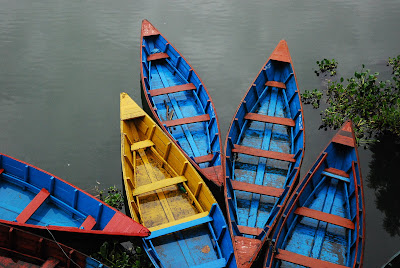Funerailles
–Prawin Adhikari
It is possible to find pirated discs of Nepali movies in New York, the city of cinema’s adolescence, even though some will say cinema was birthed by the Lumiere brothers in France, who did not conceive it. A bastard born to such a murky pedigree, cinema is nonetheless loved universally. That shadows flickering on a wall can be the carriage for narratives is not a strange concept to a species that searches for stories everywhere. This must be why cinema has a universal grammar and appeal. More often than written words or cultural rituals, music and cinema transcend differences.
Pirated discs of Nepali movies compete among a cosmopolitan chorus of cinema, to act as a familiar for homesick Nepalis before which pretenses of otherness can disappear. It is perhaps in counterpoint, that we find a film like Malami, [Funerailles in French] Subarna Thapa's gorgeous black and white twenty-minutes short, shown on November 21 at Allaince Francaise, Kathmandu: because we seek a unique Nepali voice in cinema to waft over the local cacophony.
Nepali audiences are only just waking up to short fiction in cinema, with a smattering of festivals around the country to showcase the efforts of independent and necessarily small productions. Malami has the ingredients necessary to gently introduce a new audience to short fiction: it starts with an end and ends with a beginning; the middle is stacked with social and cultural problems that require specific solutions, whether within the boundary of the movie, or in debates afterwards; and it is just strange enough to awake wonderment and the desire to knock on the door and peep through the keyhole, if not open it to see the cinematic world as it really is.
The movie sets out to alter long calcified perceptions of villagers from a dying hamlet. It is bracketed by images of the down of reeds and cotton tugged loose by a breeze, carrying between colour and its absence an arc of radical transformation of the subjects inhabiting the narrative. Malamicould be an outsider's manifesto about Nepali village life in frays, the way it pries into every hurt of every man, woman and child. Anup Baral's character talks to us as a specter floating between worlds, appearing to those who are about to die, or to a child who has acquired a mortal knowledge of the worlds. By the time the black and white pictures bleed into colours carried by light-filled forest and laughing children, the audience has seen transformative incidents, akin to watching the dead gain a will of their own.
The living, on the other hand, appear to have lost ownership of their lives. Their distress is to be measured in the absence of fathers, husbands and sons, and to be scaled through defiance of aeons old traditions. They borrow safety for unborn life by servicing the dead. In the entire village, one man alone dares speak freely without being whittled down to unimportance, and he gets away only because he speaks to an otherworldly messenger. Everybody else is tied inextricably to the community and its rules.
The community in Malami is a heavy shackle, reaching into the grave of the past and the womb of the future, skewering each individual with the burden of every other person. The men leave, as a wife points out, not only to put food in the bellies of those forgotten behind, but also to find leisure away from the village drudgery. It is a liberation that exacts its pound of flesh here, in the village, and there, in Dubai, Malaysia, Afghanistan.
As a Nepali short, Malami is atypical in its French budget, its very experienced French cinematographer, its French production team, its French screenplay co-writer and a certain French gaze that it brings to rural Nepal, a nostalgia for a lost garden. But the dialogues are very sharp, especially when an old man silently shows his eye to a burly Gurung in exasperation. Translations of cultural gestures perhaps appeal directly the spectator that is lodged deep within the mind, right next to the narrator. Without the bridge of language to cross, pictures speak volubly, excitedly, to French and Nepali audiences alike. In this regard, Malami is an unparalleled success in the very short history of short movies about Nepal.


